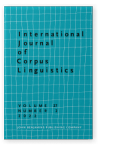Vol. 27:2 (2022) ► pp.220–247
Degrees of non-standardness
Feature-based analysis of variation in a Torlak dialect corpus
A corpus-based method for assessing a range of dialect-standard variation is presented for identifying samples exhibiting the highest prevalence of dialect features. This method provides insight into areal and inter-speaker variation and allows the extraction of maximally non-standard manifestations of the dialect, which may then be sampled and used for the study of language change and variation. The focus is on a non-standard Torlak variety, which has undergone considerable change under the influence of standard Serbian. The degree of variation is assessed by measuring the frequencies of five distinguishing linguistic features: accent position, dative reflexive si, auxiliary omission in the compound perfect, the post-positive article, and analytic case marking in the indirect object and possessive. Locations subject to the greatest and least influence of the standard are revealed using hierarchical clustering. A positive correlation between the frequencies of occurrence reveals which non-standard feature is the best predictor of the others.
Article outline
- 1.Introduction
- 2.Variation in Torlak
- 2.1Dimensions of variation
- 2.2Assessing variation
- 3.Torlak features chosen for analysis
- 3.1Selection
- 3.2Accent position
- 3.3The clitic si
- 3.4Omission of 3rd person auxiliary with l-perfect
- 3.5Post-positive article
- 3.6Analytic dative marking of the possessive and indirect object
- 3.7Operationalization
- 4.The Timok sample
- 5.Measuring variation
- 5.1Analysis
- 5.2Results
- 6.Discussion
- 7.Conclusion
- Acknowledgements
- Notes
-
References
